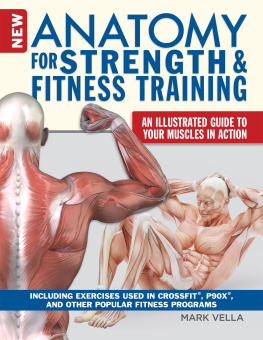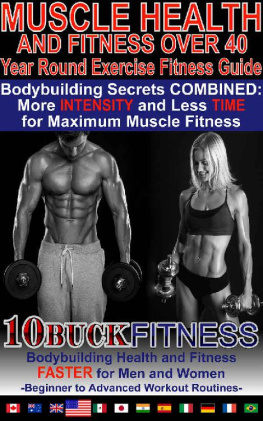Bulletproof Bodies
Copyright 2018 by Ross Clifford & Ashley Kalym. All rights reserved. No portion of this book, except for brief review, may be reproduced, stored in a retrieval system, or transmitted in any form or by any means electronic, mechanical, photocopying, recording, or otherwise without the written permission of the publisher.
First published in 2018 by Lotus Publishing
Anatomical Drawings - Amanda Williams
Photographs - Fiona Hook
Cover Design - Chris Fulcher
Preface
There has never been a better time to be involved in body-weight exercise. Over the last few years, body-weight training has held a top five position in the list of top fitness trends. But unlike wearable technology, which currently sits in first place, body-weight training is not really a trend. It is not new, and it is definitely not a fad that will fade into obscurity in the years to come. Although bodyweight exercise has been around for thousands of years as a formal training method, it existed long before this when humans increased their survival chances with running, climbing, jumping and lifting activities. It almost seems instinctive to us to use the weight of our bodies as a form of resistance.
In todays world, body-weight training is no longer an exercise option but instead a thriving community of people who value their physical function over a purely aesthetic outcome. Myriad online facilities now exist to take you from the most fundamental of human body movements through to spectacular feats of strength and flexibility, such as the human flag. There are groups that exist, bestowing kudos on their global members who achieve the Holy Grail that is the muscle-up. High-quality calisthenics books are available to explain and illustrate a range of progressive techniques and routines to suit both the novice and the expert fitness fan.
The focus of body-weight exercise has long been the development of strength, but many of the exercises will also develop mobility around joints and flexibility of muscles. This is largely because the exercises do not isolate muscle groups and immobilise large parts of the body; instead, body-weight training uses most of the body at any time while focusing the load on specific body areas. Often this requires the support of the core or stabilising muscles. All of this can be done anywhere and with a minimal amount of equipment, making it accessible in terms of location, cost and time. What more could you want?
The nature of this book differs slightly from the focus of most other body-weight training manuals and online facilities. It is the result of a partnership between a chartered physiotherapist and a calisthenics expert who have long appreciated the use of body-weight exercise in developing physical resilience to the strains of modern living, and the potential for these exercises to rehabilitate injuries that have already occurred. Without a doubt, if you were to regularly complete the exercises herein, you would develop increased strength, which is the capacity to generate force or pressure. But strength can also mean the ability to withstand force or pressure. This is the focus of Bulletproof Bodies we combine strength gains with the concept of physical resilience, which is the capacity to recover quickly from physical stress and to spring back from physical difficulty.
Our aim is to demonstrate and educate how the principles of body-weight exercise can be applied to the prevention and rehabilitation of injuries in the musculoskeletal system. No matter how hard you train and how clean you live, you must understand that some injuries are inevitable. We cannot control all events and all external forces, but we can ensure that we are physically robust enough to absorb as much of this force as possible before we reach breaking point. Once broken, however, we must then guide our bodies back to the best function possible. This book will help you in achieving both of these aims.
We hope that this book will give you a deeper understanding and appreciation of the incredible human musculoskeletal system, and that you will come to know your own body better. This is not an academic textbook for trainee health or sports professionals, but is intended as a need-to-know guide to common structures in the body and the problems that can develop. Once we have established this in an accessible way, we offer you a wide range of targeted body-weight exercises to rehabilitate and make resistant specific body areas. At the end of the book, we combine these exercises in set routines as suggestions for developing whole-body physical resilience. All of these exercises are tried and tested by both authors and have been used by us for many years to develop strength and recover from injury.
One final word regarding the exercises: at first sight you may wonder if we have misunderstood the effects of the proposed exercises. The answer is no: we have re-understood the exercises. For example, you may be familiar with the pull-up as a classic means of increasing size and strength of the back muscles, especially the latissimus dorsi muscles. Take a minute to think through this well-known exercise gripping the bar, the initial pull at the elbows, and the bend in the elbows required to bring yourself to the bar. You may now be thinking about the forearm pump that you get with this exercise. Now ask yourself is this just a back-muscle exercise? The answer again is no. Like all body-weight exercise, it is not just anything. We will hopefully help you to see the wider benefits of body-weight exercise and reinterpret the gains available to you with this most fashionable of exercise trends!
Train smart. Ross Clifford & Ashley Kalym
1. Musculoskeletal Injury
Musculoskeletal injuries or disorders can affect muscles, joints, tendons and ligaments in all parts of the body. These issues can happen at any time during the lifetime, in the active and inactive, and can seemingly occur for no known reason. There may be an obvious trauma or injury that is responsible for the disorder, but more likely than not the pain or dysfunction comes on without trauma. It may be sudden, in that you awoke with it, or it may be a slowly worsening niggle that will not go away.
If you currently have such a problem, you are not alone. Musculoskeletal injuries are widespread, with lower back pain being the most common condition, affecting nearly everyone at some point in his or her life. Estimates suggest that in developed countries 433% of the population at any given time will experience lower back pain. In some countries, musculoskeletal disorders make up around 40% of work-related illness, suggesting that you are more likely to develop a musculoskeletal problem through your daily routine rather than through any kind of sports injury. It is therefore very likely that at some point in your life, probably in the not-too-distant future, this book may be of great use to you.
In this first chapter we will briefly look at the soft- tissue repair process, differentiate chronic from acute musculoskeletal problems, and outline general types of chronic musculoskeletal disorders.
Soft-tissue Injury and Repair
If at any point a force is applied to the musculoskeletal structures that exceeds their ability to withstand that force, there will be disruption to the normal structure and function of that tissue. This may be minor and give you nothing more than a dull ache for a day or two. If you are no stranger to exercise or physical work, you may recognise this as muscle soreness, where there has been minor damage to the muscle tissue. With adequate rest and nutrition (see Chapter 4), this ache will subside as the inflammatory process passes and the muscle fibres are repaired and perhaps even made thicker and stronger. All of this is a normal process and happens on a daily basis as our musculoskeletal systems respond to the dynamic ebb and flow of forces applied to our bodies.




